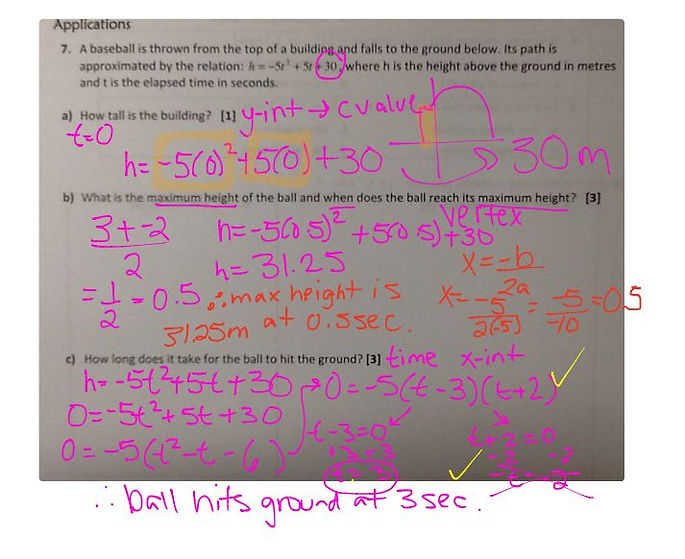Flight Problem
Throughout this section, we will be learning how to apply our knowledge about quadratics to solve flight/motion problems (optimization included). Please look below to see a sample problem that we will be analyzing:
ANALYSIS: *Please refer below to see the analysis of each section of the sample flight problem given above.*
7. a) In this section of the word problem, it is asking us to find the height of the building. From the knowledge we have acquired throughout the navigation of this website, we can conclude that this problem is asking us to find the y-intercept (height of the building). If we recall the standard form equation, it is very simple to find the height of the building. This is because the c-value in y=Ax^2+Bx+C is the y-intercept, hence it is the height of the building. If we refer back to our sample problem, we notice that the c-value is 30. Hence, the height of the building is 30m. Knowing that we need to find the y-intercept to find the height of the building, we can also substitute t=0, as it is the x-value. When we substitute t=0 into the equation y=-5t^2+5t+30, we get y=30 as the answer. Hence, the height of the building is 30m.
b) In this section of the word problem, it is asking us to find the maximum height of the ball (optimal value), and the time it reaches its maximum height (axis of symmetry). In essence, it is asking us to find the vertex, as the vertex is the point which incorporates both the axis of symmetry (x-value of vertex) and the optimal value (y-value of the vertex). In order to solve this problem, one of the first things we need to do is to find the x-intercepts. This is because from there, we can find our axis of symmetry, which is the midpoint between the two x-intercepts. And in this case, it is also our time the ball reaches its maximum height. The way we find our x-intercepts is by factoring the equation y=-5t^2+5t+30, and then by setting each factor equal to 0. **Look at 7.c) to see how to solve for the two x-intercepts.** Once we have found the x-intercepts, which in this case were (3,0) and (-2,0), we use the formula: (r+s)/2, to find the axis of symmetry. In this case, the axis of symmetry was x=0.5. Thus, the ball reaches its maximum height at 0.5 seconds. Now since we have found the axis of symmetry, all we need to do is to take that value and substitute it into the equation for t, to solve for the optimal value, which is the maximum height of the ball. In this case, the optimal value (max. height of the ball) is 31.25 metres.
c) In this section of the word problem, it is asking us to solve for the x-intercepts (roots/zeroes). The way we find our x-intercepts is by factoring the equation y=-5t^2+5t+30, and then by setting each factor equal to 0. In order to factor the following equation, we would first need to common factor out the -5, and then use simple trinomial factoring to factor for the remainder of the equation. Once all the mathematical calculations are completed, you should get (3,0) and (-2,0), as your two x-intercepts. Now in order to find the time at which the ball hits the ground, we need to pick the most reasonable x-intercept. In this case the most reasonable x-intercept is (3,0) because time cannot go into the negative. Thus, the ball hits the ground at the time of 3 seconds.

